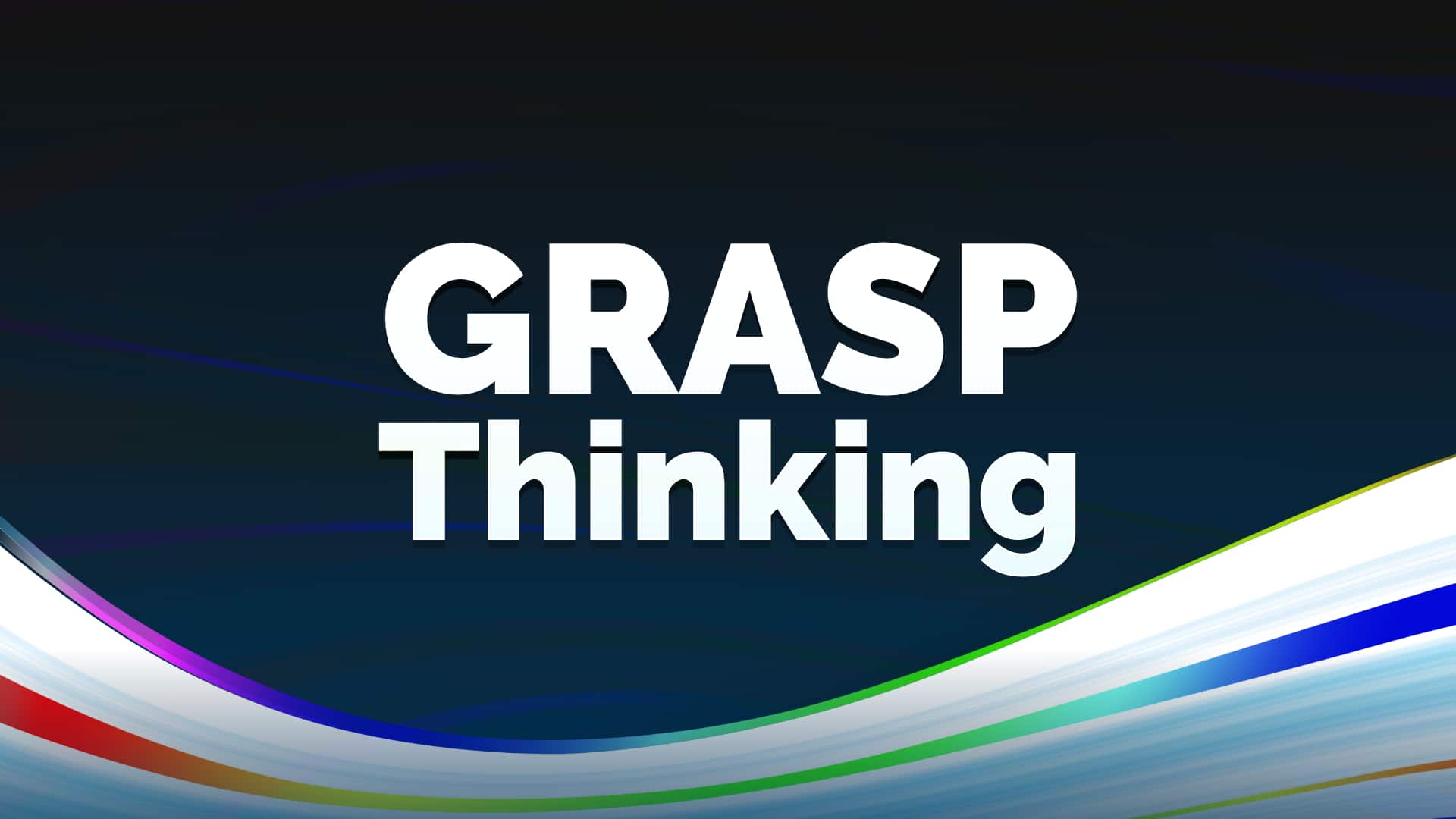October 16, 2024
GRASP Thinking – What Could One Killer Idea Mean to You

We live in an age of constant change where we need to be fighting fit if we’re to maintain a standing in our market or profession. New knowledge, competition and technological developments are assailing us at every level, so it’s becoming virtually impossible to remain on our feet. And as new situations arise, we come face to face with problems, opportunities and challenges that require increasingly novel solutions.
What worked in the past no longer fits the bill so we’re being forced to ‘up our game’ with a new arsenal of creative insights and approaches to stand the best chance of succeeding. In the heat of it all, there’s little hope or choice for us other than through continued growth, adaptation, creativity, productivity and innovation.
“In today’s age of change, as soon as you achieve success, someone is nipping at your heels, learning your unique strengths and planning to take a portion of your market. The only way to succeed is to have the ability to change – rapidly and repeatedly. This requires perpetual innovation from you and your entire staff at all times.”
Stephen Shapiro, Author of ‘24/7 Innovation’
The majority of us have already made a keen start on becoming more creatively productive and we’ve come to depend on any number of accessible tools and skills to help us. From the latest brainstorming software to the ‘hottest’ new management techniques, we’ve embraced anything we believe will provide an effective answer to the multiple challenges we face. We’ve even gone as far as to adopt different business models to shake up the way we work and help us get ahead. Yet even the most self-aware among us will easily overlook the one primary resource which has the capacity to unleash unparalleled creativity and transformation – the human mind. The climate for successful innovation and productivity doesn’t begin with the newest management theory or technological fad, it begins with our thinking. How can we expect to promote serious creative growth without understanding where it comes from in the first place?

Thinking about Thinking
There’s nothing more important in your life than your thinking. Whether you’re looking to start a new venture, attract more customers or just reorganise your workload, the greatest advantage you can have is the ability to think in the correct way. This may appear to be a bold statement but consider it for a moment…
Q) If you could come up with that one killer idea, that one moment of brilliance, what would it be worth to you?
My guess is that it would be worth a huge deal to your future, and you wouldn’t be alone in that regard. Anyone who aspires to excellence in business knows that the generation of ideas – especially creative, high quality ideas – is not only beneficial to their success; it’s a vital ‘make or break’ factor. Indeed, the consulting company Booz Allen and Hamilton Inc concluded from a study of top management that:
“Nowhere inside the business is there any factor as potentially valuable as the ‘Big Idea’… At any given time, an outstanding idea can produce more dollars of profits than years of cost reduction programs.”
The killer ideas and solutions that drive your business forward don’t just simply fall from the sky. They come from using the power of your mind – your thinking.
Thinking is at the heart of everything we do. It encompasses all of the mental activities associated with concept-formation, problem solving, intellectual functioning, creativity, learning memory, symbolic processing and so on. In other words, it’s the starting place for every possible pursuit or task. So doesn’t it correspond that the more effectively we use our thinking, the more successful we’ll be in what we’re doing?
“If I have any advice to pass on, as a successful man, it is this: if one wants to be successful, one must think; one must think until it hurts.”
Roy Thomson, Canadian businessman and author of ‘After I was Sixty: A Chapter of Autobiography’

Unfortunately, most of us never stop to think about how we think. At an intellectual level, we can recognise that our thinking is important, but we seldom take the time to understand it or learn how to handle it effectively. However, just as we manage our workload, our staff and our personal lives, we also need to manage our minds. By taking charge of our thinking, we remove the ambiguity out of making business decisions and can move forward to tread new paths clearly and confidently. Good thinking practices also make it much easier to ‘see’ the most innovative solutions to our pressing challenges and everyday problems – it’s akin to working in bright daylight instead of fumbling around in the dark.
Being able to go beyond conventional thinking is particularly crucial if we’re to cope in this new ‘creative age’ where the ability to source and process information is no longer a competitive advantage. As Deborah Gough, a prominent educator and researcher on thinking skills, points out, “Specific knowledge will not be as important to tomorrow’s citizens as the ability to learn and make sense of new information”. Innovation requires that you use information differently to create unique ideas and convert them quickly into action.
“The process of creation starts with thought – an idea, conception, visualization. Everything you see was once someone’s idea. Nothing exists in your world that did not first exist as pure thought.”
Neale Donald Walsch, American author of the series ‘Conversations with God’
If you consider that all successful endeavours in the fields of engineering, medicine, architecture and business began as just a thought in someone’s head, then creativity involves little more than the capacity to apply your mind. The most innovative and useful ideas are the result of good, intentional thinking – the type of thinking that forces you to find opportunities and make things happen. The way you think can therefore propel you to success, or hold you back. Naturally the ‘winners’ in life are those of us who learn to take charge of and use our thinking so that it serves us in the right ways.

There are countless tools, techniques and systems we could apply to encourage everyday innovation and creative problem solving. But it’s only once we’ve developed a real awareness of our thinking that the introduction of new tools, techniques and systems will make any practical sense. If you understand something, you’re better able to control it instead of allowing it to control you. Once you know how to think, you can promptly set up an organised approach for identifying problems and opportunities, generating ideas and solutions, evaluating alternatives and deciding on courses of action; and you can guarantee that it will be the most appropriate one for your needs.
How, then, can we understand our thinking? How can we help ourselves and others to practice better thinking and problem solving on a regular basis?…The answer is simple to GRASP.
“You are today where the thoughts of yesterday have brought you and you will be tomorrow where the thoughts of today take you.”
Blaise Pascal, French philosopher and physicist
GRASP – Our Modes of Thinking
As with anything in life, the more you put into it, the more you get out of it. If you want to be more creative and productive, then you have to focus your energy and attention on setting up the most creative and productive environment. And I’m emphatic in saying that this must always begin with your thinking.
GRASP is a concept that gets you thinking about your thinking so you can ultimately get more from your thinking. It’s an acronym that makes it easy for you and others to recognise the modes of thinking that you can adopt at any one time. With this understanding you’re better placed to take charge of a situation and deliver the innovative and useful outcomes you want.
So what does GRASP actually stand for?
It stands for the various modes of thinking that people should be aware of. These are:
Generative – Generating thoughts and ideas
Reactive – Reacting to existing influences and ideas
Analytical – Analysing ideas to reach a solution
Selective – Validating and implementing a potential solution
Proactive – The strategy of thinking (encompassing all of the above)
There’s nothing radically new or complicated about GRASP. Most people are already somewhat acquainted with these modes of thinking, based as they are on widespread psychology and scientific research. Of course, as human beings we’re not limited exclusively to the GRASP modes of thinking, there are other modes we can engage in. However, the GRASP modes are those that I’ve been able to isolate explicitly in view of their relevance to creative problem solving and innovation.
“Everything should be made as simple as possible but no simpler.”
Albert Einstein, Nobel Prize winning theoretical physicist
In my experience and involvement with numerous business people and educators, one thing that’s become increasingly evident is that no matter how much we already know about our thinking and the various modes we can adopt, we rarely, if ever, consciously apply them when we’re going about a task. Hence this is where GRASP’s true power lies – as a simple and credible way to help you become mindful of your thinking so you can ultimately orchestrate the best mental environment for what you need to do or achieve. This method applies whether you’re making a huge life changing decision or simply looking to resolve a niggling technical issue.
All the modes of thinking are important to us. In an activity like problem solving, we might apply a number of them concurrently, so they aren’t entirely exclusive of each other. The problem is we hardly ever use and combine them in the correct way. One of the most significant discoveries in contemporary psychology is that we choose how we think. In developing GRASP, I wanted to present a means through which we could examine and understand our thinking so that we could do exactly that – choose how to think while tackling certain tasks.
